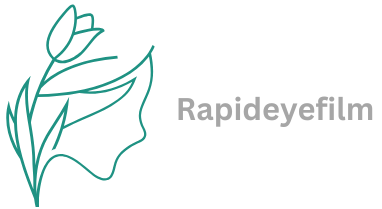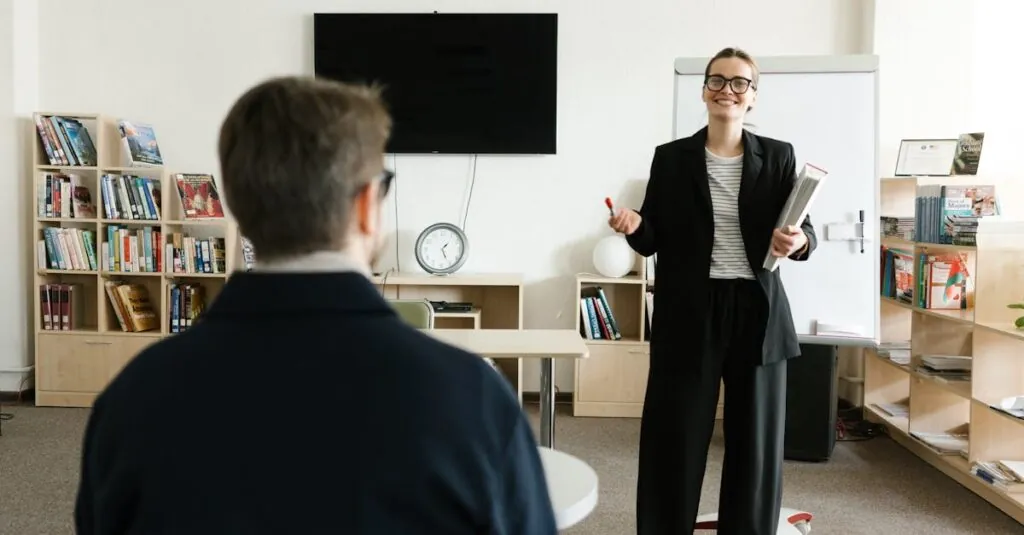Table of Contents
ToggleIn a world overflowing with words, visual language learning emerges as the superhero we never knew we needed. Imagine trying to decipher a complex recipe only to find it’s illustrated with stick figures and squiggly lines. Suddenly, that dish doesn’t seem so intimidating. Visual learning taps into our brain’s natural affinity for images, making it easier to grasp concepts and retain information.
Whether you’re a student struggling with foreign languages or a professional aiming to enhance communication skills, embracing this approach can transform the way you learn. It’s like swapping out a flat, boring map for a vibrant treasure hunt. So grab your magnifying glass and prepare to unlock the hidden treasures of language through visuals. Who knew learning could be this much fun?
Overview of Visual Language Learning
Visual language learning engages students through images, symbols, and other visual tools. This method enhances comprehension by breaking down complex ideas into easily digestible formats. Learners can connect new vocabulary to visual representations, which aids in retention.
Incorporating graphics, diagrams, and videos makes the learning process more dynamic. Traditional methods often rely heavily on text, which can hinder understanding, while visual elements provide context and clarity. The synergy between words and visuals leads to deeper cognitive processing.
Studies indicate that approximately 65% of the population are visual learners. These individuals benefit significantly from visual aids that align with their learning styles. Enhanced engagement results in improved performance, making learning more effective and less daunting.
Visual language learning fosters creativity and critical thinking. Through the use of infographics and mind maps, learners analyze and synthesize information more effectively. Illustrative scenarios also promote real-world application, bridging the gap between theory and practice.
Adopting visual strategies in language learning sessions facilitates collaboration among peers. Group activities, where participants create presentations or visually rich storytelling, encourage discussion and collective understanding. Increased interaction makes the environment more stimulating.
Ultimately, visual language learning transforms the educational experience. It encourages exploration and discovery while making complex information approachable. By utilizing vivid imagery and clear examples, learners embark on a journey that not only enriches their language skills but also makes the process enjoyable.
Benefits of Visual Language Learning
Visual language learning offers significant advantages, enhancing the educational experience. Engaging with visual aids not only makes learning enjoyable but also reinforces key concepts effectively.
Enhanced Retention and Recall
Incorporating visuals aids memory retention. Studies indicate that about 65% of individuals are visual learners. Utilizing images, diagrams, and charts helps learners retain information more effectively. Visual elements create strong associations, linking concepts with memorable visuals. As a result, recalling information becomes easier and more intuitive. Teachers can enhance lessons by integrating visual stimuli to support retention. For example, learners may remember vocabulary better with corresponding images rather than text alone. Effective use of visuals encourages lasting memory, leading to improved academic performance.
Improved Comprehension Skills
Visual language learning significantly boosts comprehension skills. When learners encounter complex concepts, visuals simplify understanding. Infographics or mind maps clarify intricate ideas. Visual representations provide context, breaking down barriers to comprehension. Students often grasp topics faster when presented visually, as this approach promotes active engagement. Through group activities, visuals encourage collaborative discussions that deepen understanding. Using multimedia resources such as videos and animations also enhances comprehension. Engaging with varied visual tools primes learners to synthesize information efficiently, fostering critical thinking and analysis.
Techniques in Visual Language Learning
Visual language learning employs various techniques to enhance comprehension and retention. By integrating creative approaches, learners engage more effectively with complex concepts.
Use of Infographics and Diagrams
Infographics and diagrams simplify information presentation. They break down intricate ideas into visual formats, making them easier to digest. Combining text and images creates strong associations, which improves memory retention. Learners often recall information better when it’s visually represented. Examples include flowcharts and charts that illustrate concepts clearly. Teachers can utilize these tools to foster active engagement during lessons. Studies suggest visual formats improve understanding by about 70% compared to traditional methods.
Incorporating Multimedia Resources
Multimedia resources engage students through videos, audio, and interactive content. By combining sound and visuals, these tools cater to different learning preferences, capturing attention effectively. Videos can illustrate vocabulary in context, enhancing comprehension. Additionally, interactive activities allow learners to practice language skills actively. This hands-on approach promotes collaboration and discussion among peers, enriching the learning environment. Additionally, platforms like online courses provide access to diverse multimedia resources, expanding learning opportunities. Such techniques support the assertion that approximately 65% of learners benefit from visual stimuli in education.
Challenges in Visual Language Learning
Visual language learning presents various challenges that can impact its effectiveness. Understanding these obstacles helps educators and learners navigate the landscape of visual aids more successfully.
Accessibility Issues
Accessibility can pose significant challenges in visual language learning. Not all learners have equal access to technology or resources necessary for engaging with visual materials. Some students may struggle with visual impairments, making it difficult for them to benefit from graphics and images. Additionally, language technologies or platforms may lack support for diverse learning needs, hindering overall participation. It’s crucial for educators to consider these factors when integrating visual tools into lesson plans. Implementing alternative formats—such as audio descriptions—can enhance inclusivity, ensuring that every learner engages effectively.
Balancing Visuals with Text
Balancing visuals with text is another critical challenge in visual language learning. Excessive visual elements can overwhelm or distract learners, leading to cognitive overload. Thoughtful integration of visuals and written information maintains clarity and focus. While about 70% of learners show improved understanding with combined text and images, it’s important to find the right mix. Simplifying complex ideas with visuals while providing concise text explanations enhances comprehension. Educators must adapt their methods to ensure that visual learning tools complement textual information, creating a harmonious learning environment that supports both visual and textual processing.
Future Trends in Visual Language Learning
Emerging technologies are revolutionizing visual language learning, incorporating augmented reality (AR) and virtual reality (VR) to create immersive experiences. Learners engage with language environments where they can interact with virtual objects and scenarios, making lessons more dynamic and memorable.
Artificial intelligence (AI) tools are also shaping the future by providing personalized learning experiences. These tools adapt to individual proficiency levels, offering tailored visuals and feedback that match learners’ needs.
Data analytics plays a critical role, allowing educators to track progress and engagement in real-time. Analytics can identify which visual tools enhance retention most effectively, guiding curriculum adjustments to optimize outcomes.
Mobile applications are becoming increasingly popular, offering accessible platforms for visual language learning. Learners can access lessons anytime, incorporating visual elements like flashcards, quizzes, and videos conveniently.
Collaboration will expand, with online communities sharing resources and strategies. Visual language learning can become more inclusive as learners collaborate on projects, drawing from diverse perspectives to enhance collective understanding.
Gamification is another trend gaining traction, incentivizing students through visual rewards and challenges. This approach enhances motivation and engagement, making learning fun while reinforcing language skills.
Incorporating social media can foster a sense of community among learners. Sharing visuals, progress, and insights on platforms enhances motivation and creates informal learning opportunities outside traditional settings.
The focus on inclusivity remains paramount, ensuring resources cater to diverse learning needs. By prioritizing accessibility and creating visuals that resonate with all learners, the field can continue to evolve and thrive.
Visual language learning stands as a powerful tool in the modern educational landscape. By harnessing the strengths of visual aids learners can engage more deeply with material while enhancing their retention and understanding. This approach not only makes learning enjoyable but also fosters creativity and collaboration among peers.
As technology continues to evolve innovative methods like AR and VR are set to further enrich this learning experience. By prioritizing inclusivity and accessibility the future of visual language learning promises to cater to diverse needs ensuring that everyone can benefit from this dynamic approach. Embracing visual language learning is not just a trend; it’s a pathway to mastering languages effectively and joyfully.




